`Stop Press' Stories
For stories in 1999, click here
For stories January to April 2000, click here
For stories May to December 2000, click here
For stories January to April 2001, click here
For stories May to
August 2001, click here
For stories September to
December 2001, click here
For stories January to April 2002, click here
For stories June to September 2002, click here
For stories September to December 2002, click here
For stories January to June 2003, click here
For stories June to October 2003, click here
For stories October 2003 to December 2003, click here
For the latest stories from January 2004, see below
![]()
Extraneous Signals
(7 June 04) |
|
Extraneous Signals
When a weather station temperature is affected by construction nearby of
new buildings, roads, and so forth, the phrase "urban heat island", or
perhaps "urban heat island effect", may be used to indicate that the
subsequent temperature readings of such a weather station may be biased
by local conditions (even if the location may not commonly be considered
urban).
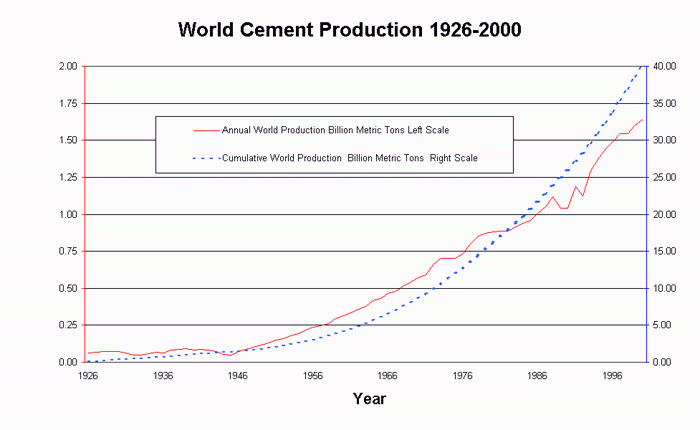
It would seem that there is much construction occurring, somewhere. However, urban heat island effects are local phenomena, and it may be useful to have a way to estimate such effects in the vicinities of weather stations. In a recently published paper, "A Test of Corrections for Extraneous Signals in Gridded Surface Temperature Data", described there, Ross McKitrick and Pat Michaels offer a method to estimate urban heat island effects more accurately than methods used by sources preferred by IPCC management. Whether their method will fare well under critical analysis is one question. If it does, then there is the very different question of whether it will be welcomed by those who manage the IPCC.
Theodor Landscheidt
After a serious illness, Theodor Landscheidt passed away on Wednesday,
May 19, 2004. Regular visitors here will know of him through several
of his recent papers published here.
Miscellaneous Notions, Comments, and Observations
That does not read like a "Stop Press" headline because it is not, but
the current format does not provide a suitable place for it. So, a
place has been added for items that do not quite fit elsewhere in the
current format.
"Showing" what isn't so
A press release from the University of Washington
asserts:
Nenana Ice Classic 2004 Results
The Tanana River officially went out on April 24th, 2004 at 2:16 p.m.
Alaska Standard Time. There were 6 winning tickets. Each had the exact
month, day, hour and minute.
Large Negative Southern Oscillation Daily Values
First, the caveat:
Reality Checks Bounce (26 Mar 04) updated (28 Mar 04)
According to the Evening Times of Glasgow, Scotland, 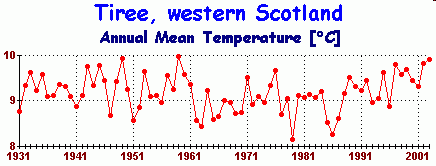
The report also revealed that most people in Scotland do not understand that one of the main causes of climate change is domestic energy consumption.See above comment about "the way some people talk". Meanwhile, in Asheville, NC, USA, home of the US NOAA NCDC (National Climate Data Center), a Citizen-Times editorial anounces: U.S., world can no longer afford to put off actions to reverse climate change. Hmmm, "actions to reverse climate change". What was that about reality? Federal scientists have found the "smoking gun" that proves human activity is having an effect on earth's climate. The only question is whether we will act before it is too late.Well, no, that is not by any stretch the only question. For example, there are the questions of what magnitudes, and what kinds, of effects? For another, how does the alledged "smoking gun" "prove" any such effects? Not surprisingly, answers to those questions are not to be found in that editorial. Indeed, the editorial does not even explicitly identify the alledged "smoking gun"; it merely lets readers assume to what that phrase refers. Another obvious question would be "too late" for what? Too late for the next global cooling, perhaps? When writing a few days ago about an AP CO2 "story", I was reminded of a common lament about inept news "reporters": don't those guys have editors? It would seem that regarding this Citizen-Times editorial, the editor needs an editor. Perhaps NCDC Director Thomas Karl could help the editor find a way through the smoke. Climate change, usually termed global warming, is one of those subjects that is ripe for demagoguery.the editorial says, and proceeds to walk the talk. Further, as long ago as 1995, the U.N.-sponsored Intergovernmental Panel on Climate Change concluded tentatively that "The balance of evidence suggests that there is a discernible human influence on global climate."Except it was not the IPCC which "concluded" that; it was Santer et al, see how. Santer also happened to be in a position to slip that bit into chapter eight of the IPCC SAR in what seems to have been an example of "climate change science" in action. Most frightening is the possibility of a large-scale meltdown of the polar ice sheets, resulting in higher sea levels.Talk about demagoguery. No evidence; simply a mention of "the possiblilty". Paradoxically, increases in some pollutants could actually help cool the planet in the short run by blocking some of the sun's heat. This is believed to be the reason that the surge in fossil fuel use after World War II did not result in warming until the 1970s.More demagoguery. Believed by whom? Again, no evidence; simply the assertion that something is believed by anonymous believers. Perhaps someday the editor would care to elaborate on that "believed" "reason", possibly by referring readers to something such as a graph displaying the UK CRU's estimates of global, and hemispheric, temperature variances from a recent average. Perhaps there might be a suggestion that the relative changes between the northern, and the southern, hemispheres might support such a "believed" "reason" on the supposition that "increases in some pollutants" may have occurred mainly in the northern hemisphere, inasmuch as that was where most of the fighting occurred, and most of the "surge in fossil use" occurred, and there were smoking guns all over the place, and they were real. However, if one compares those relative hemispheric changes, one notices that, according to the CRU's estimates, the southern hemisphere got relatively cooler than the northern hemisphere during the decade starting in 1946: 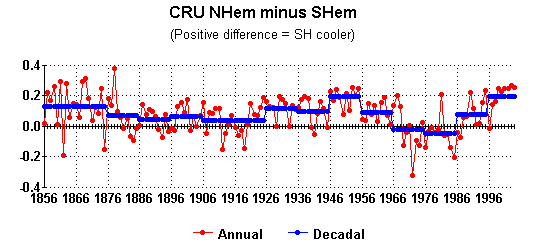
So, it just may be that the only "smoking gun" that might be related to that editorial, was the one pointing at the editor's foot. As an exercise for our visitors, I will let you discover what the editorial has to say about the Kyoto Protocol. Hint: the editor seems not to have read Fred Singer's excellent recent article.
The Kyoto Protocol: A Post-Mortem
CO2 Report Makes the Rounds (21 Mar 04) updated (23 Mar 04)
Carbon Dioxide Reported at Record Levels
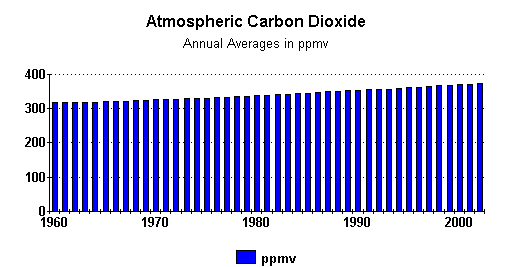
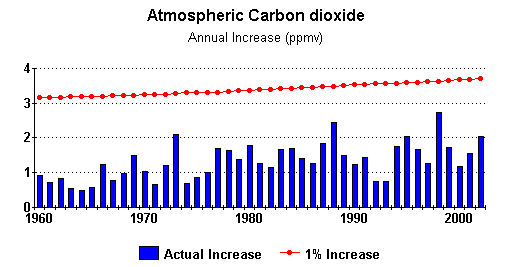
On Saturday, March 20, an AP (Associated Press) story began making the rounds, and by Sunday, it was posted on several dozens of "news" websites hither and yon, and perhaps beyond yon. How much of the story might be credible is anyone's guess. Aside from the generic CO2 phobia displayed, there are statements that are particularly pertinent to the "story" of the story, but are either false, or too vague to tell the "story". For example: "Average readings at the 11,141-foot Mauna Loa Observatory, where carbon dioxide density peaks each northern winter, hovered around 379 parts per million on Friday, compared with about 376 a year ago." The part about "where carbon dioxide density peaks each northern winter" is, shall I say, not supported by the evidence at the above referenced CDIAC link, unless the month of May got moved to the winter, and someone forgot to tell us. The "hovered around 379 parts per million on Friday, compared with about 376 a year ago" part is too vague, and possibly false. It's so vague that one cannot be sure that the author has a grasp of his subject. It does not specify the period for which the average of 379 ppm was calculated. Was it one day? If so, it is not comparable to the monthly averages available at CDIAC. Was it for one month? If so, which month? Was it for one year? If so, someone must have a time machine at their disposal in order to be able to compare last year's annual average with this year's annual average, since this year is not yet quite complete. So, it seems that we must wait a while to find out the real "story" of the story. Some additional comments on the "story" may be found under the appropriate title: Global Warming: Why Can't the Mainstream Press Get Even Basic Facts Right?. Miceal O'Ronain has provided, in both tabular , and graphical , forms, nice compilations of year to year differences of monthly averages of Mauna Loa CO2 measurements. Among them are several in excess of 3 ppm.
Too Wet?
(17 Mar 04)
Satellite finds warming "relative" to humidity
Lomborg Announcement (12 Mar 04)
Scientific Dishonesty Committee Withdraws Lomborg Case
Do you have the time? (7 Mar 04)
A note received today recalled reports of a "study" published in
February of 2002:
In the 3 March 2004 edition of their CO2 Science Magazine, Sherwood,
Keith, and Craig Idso welcome a new Scientific and Policy Advisor to
their Center:
In his "The Australian" article,
No future in Kyoto Protocol, Alan Wood reminds us that the IPCC
dabbles not merely in 100 year climate prophecy, but also in 100 year
economic prophecy.
"Secret Pentagon Report" (24 Feb 04)
The London UK Observer story gasps: It began as an obscure theory from the fringes of scientific thinking on climate, the idea that `global warming' could conspire to plunge Europe and the northeast of North America into a new ice age - and do so within our lifetimes. The theory basically says that an increasing influx of fresh water into the North Atlantic `could' disrupt the natural sinking of salt water in the Arctic seas off Norway which draws warmer water from the south - the Gulf Stream which warms Europe. With no Gulf Stream, Europe `could' plunge into similar climatic conditions as those of Labrador, Canada, which is on similar latitudes. In other words, global warming could trigger a new ice age in Europe. And the precedent for this outlandish scenario? 10,700 years ago, such an event did occur - the `Younger Dryas', where humungous floods of fresh water running off the melting ice caps over North America and Europe did freshen the North Atlantic sufficiently to shut down the Gulf Stream for about 300 years. Once these ice caps had melted away, the North Atlantic became sufficiently salty again to allow the Gulf Stream to re-establish itself. But where will these enormous quantities of fresh water come from today? The industry says, coyly, `more rainfall' - from global warming. This is an absurd proposition because no amount of rain could rival the massive melt-water runoff that occurred during the Younger Dryas. If the Gulf Stream were weakening, there would be an expansion of Arctic sea ice into the high North Atlantic where the Gulf Stream finally sinks to the ocean depths, returning via the ocean floor. But no such ice expansion is taking place. Indeed, some scientists claim that sea ice is shrinking, not expanding, which suggests the Gulf Stream is as strong, or stronger, than ever. That was the theory, a parasitic adjunct to the broader global warming theory, supported as usual by `models'. Then `Auntie' herself, the BBC, started the process of softening up the public for this new apocalyptic vision with this TV documentary titled `The Big Chill' late last year on how it might all start and unfold. It was scary stuff, especially as the British public are apt to believe the BBC over and above all other media. The latest contribution now comes from The Independent (UK) with this scare story by their environment editor, Geoffrey Lean. He opens with this dramatic headline - "Global Warming Will Plunge Britain Into New Ice Age 'Within Decades' ", followed by this opening statement: "Britain is likely to be plunged into an ice age within our lifetime by global warming, new research suggests." (Notice how `will' became `is likely to' in succeeding sentences). Yes, it's always some dramatic `new research', from an industry that has only ever prospered from creating public alarm. The usual "much worse than previously thought" is a standard cliché for such stories.  In May this year, new fuel
will be added to the fire with the release of the Hollywood blockbuster
`The Day
After Tomorrow', starring Dennis Quaid as a `climatologist'.
Quaid was excellent as the ever-grinning father of girl twins in `The
Parent Trap', but his latest movie will see him cast as an
environmentalist hero in this latest of a long line of Hollywood disaster
movies.
In May this year, new fuel
will be added to the fire with the release of the Hollywood blockbuster
`The Day
After Tomorrow', starring Dennis Quaid as a `climatologist'.
Quaid was excellent as the ever-grinning father of girl twins in `The
Parent Trap', but his latest movie will see him cast as an
environmentalist hero in this latest of a long line of Hollywood disaster
movies.The movie will probably be well worth seeing, for the special effects if nothing else, but it is just a movie for entertainment, not be taken seriously. Now that the scare is on for real, the whole industry is joining the bandwagon like a downhill avalanche, gathering more momentum the longer it lasts. It is a case study, not of climate science, but of a hysterical mass psychology in action among society's more gullible intellectuals and climate scientists who should know better. It was a fundamental scientific error for the industry to identify individual weather events like heat waves and droughts as being indicators of global warming. Events as diverse as floods in Britain, Australian bush fires, the European heat wave of 2003, Atlantic hurricanes, tornado events, and droughts in Australia and the US have been variously blamed by top industry scientists on `global warming'. They even claim that the climate models predict such events, even though climate models are by definition climate models, not weather models. In other words, they are not even designed to predict weather events, let alone link such events to `global warming'. Example here. The logical trap in linking weather events to global warming is that cold events (such as the recent Arctic cold wave which swept North America and recently south-eastern Europe and Turkey) which run completely counter to the global warming theory, must also be explained in terms of that theory. That is where this new `ice age' scare is so useful for an industry which spends its whole time (and taxpayers money) dreaming up one global catastrophe scenario after another. By invoking the possibility of `global warming causing an ice age', the industry are now in the position of being able to point to each and every weather event, whether hot or cold, as being evidence of global warming. Heads we win, tails you lose. It has become a closed logical system where the theory is now impervious to any external evidence which may contradict it. And this is an intellectual black hole which climate scientists themselves were not pushed into, but enthusiastically jumped into with scant regard for basic principles of science. So, don't blame the media - climate science is itself to blame for this absurd situation where an entire science is now impervious to any internal or external evidence which might question the quasi-religion they have embraced. Demonstrated expertise in any complex discipline commands some authority among the non-expert public. But the many errors of this particular science are so gross that they have squandered whatever little authority they did have. Headaches, migraines, nausea, dizziness, palpitations, tinnitus, sleep disturbance, stress, anxiety and depression. These symptoms are all identified by new medical research in Britain as reported recently in The Telegraph (UK) And the cause? Proximity to low frequency noise, known as `infrasound', emitted by the thrashing blades from wind farms. One victim described the noise "as if someone was mixing cement in the sky." The danger of infrasound is that it is not merely audible like ordinary sound, but also resonates with the very structure of the human body, causing unpleasant vibrations that can be felt in the chest, head, legs etc. Wind farms are not only useless energy devices, but are now also a health hazard. The four headlines shown below were typical of media reports on the severe Arctic chill which descended on the northeast of the USA last week. 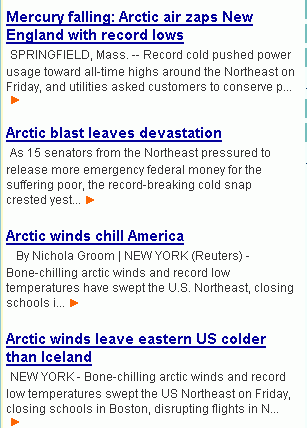
In these headlines, the word `Arctic' was used six times to describe the conditions faced. The fact this event occurred at all suggests `global warming' is either non-existent or much too feeble an effect to be concerned about on a global level. It is a non-problem. On this performance, there will be no 5.8°C warming as claimed by the IPCC in one of their dozens of fantasy `storylines'. Even with CO2 doubling 100-150 years from now, the global temperature increase is unlikely to exceed even one degree, let alone six. But these headlines tell us something else too - How many times have we heard that the Arctic itself is warming? A combination of selective evidence and wishful thinking has resulted in some scientists and environmentalists talking themselves into believing that the Arctic really was warming. Well, it was the `warmer' Arctic air
which hit back last week, so `warm' that cold records were tumbling all
across the northeast. A Winter's Tale from Al Gore (17 Jan 04) While President George Bush may be eager to get off the planet with his `men to Mars' announcement, his 2000 (and possibly 2004) presidential rival, Al Gore, appears to be already off it. He chose this of all weeks to repeat his clarion call for America to stop `global warming'. While Gore was making his global warming speech on Thursday 15th January, the US media was swept up in other, more urgent, headlines.
CNN (USA)
-
"Freeze Strains Northeast Power Grid"
- 16 Jan 04 According to Gore, "I don’t think there is any longer a credible basis for doubting that the earth’s atmosphere is heating up because of global warming... Global Warming is real. It is happening already and the anticipated consequences are unacceptable." Tell that to the thousands shivering in the coldest US winter for many decades. While this winter's freeze in North America is close to being a record-breaker, the fact it has happened at all is a sure sign that `global warming', if it exists at all, is much more feeble than the greenhouse scientists dare to admit. And why would they admit it? To do so would put an abrupt end their $4 billion-a-year party funded by the taxpayers. Every time Nature dumps a massive cold snap somewhere, that alone provides a credible basis for doubting the IPCC's hysterical predictions of rampant warming. It isn't enough to merely say the atmosphere is warming. How much it may be warming is the critical issue. A feeble warming over many decades will make scarcely any difference to global climate and that's all that can be claimed for the last 25 years - a feeble warming, most of it caused by slightly increased radiation from the sun. Gore also slurs the so-called `climate skeptics' (such as this website). He said "Yet in spite of the clear evidence available all around us, there are many who still do not believe that Global Warming is a problem at all. And it’s no wonder: because they are the targets of a massive and well-organized campaign of disinformation lavishly funded by polluters who are determined to prevent any action to reduce the greenhouse gas emissions that cause global warming, out of a fear that their profits might be affected if they had to stop dumping so much pollution into the atmosphere." Lavishly funded by polluters? `Still Waiting for Greenhouse' is one of the few websites openly skeptical of the IPCC's scenarios of gloom and doom, and a primary source of what Gore regards as `disinformation'. His `lavish funding' accusation is not just disinformation by him, but also an outright lie. In the last 12 months, this website has received funding of - wait for it - $50. That `lavish funding' took the form of a single donation cheque to this website. A powerful motive indeed to spread disinformation. My information from other skeptic sources suggests equally small amounts being donated. We do what we do because we believe strongly in the truth of our case regardless of the level of, or lack of, funding. The fact that a $4-billion-a-year industry feels threatened by skeptics working on a financial shoestring speaks volumes about the bankruptcy of the industry's message and their resort to character slurs. If the `polluters' have really been dumping
`lavish funding' on the skeptics, the cheques must still be in the mail. Species Extinction - One Million, or Just One? (12 Jan 04) A new modelling study published in Nature, [Thomas et al, v.427 p.145, 8 Jan 04] and publicised widely in the media (e.g. here and here), has led to claims that a million of the world's species `could' become extinct by 2050 as a direct result of `climate change'. The study focuses on several regions of the world including Australia, Brazil, Europe, Mexico, South Africa, and Costa Rica. In one example, the BBC report on the study claims that nearly half of all protea flowering plants in South Africa `could' become extinct due to climate change. The habitat range of these plants is shown on the left (the area shaded in brown), and the temperature record from Capetown, in the centre of that range, is shown on the right. As is clearly evident, the warmest period of the last 150 years was the 1930s, not the present. Clearly if the plants survived that period, they cannot be regarded as being vulnerable to `climate change'. The claims are therefore entirely speculative and without scientific foundation. 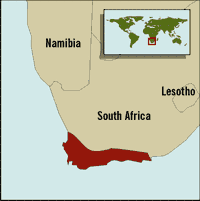
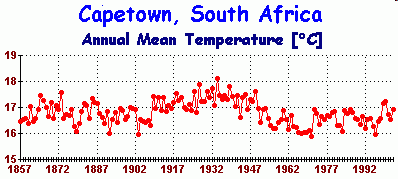
In another example, this time a bird species, the BBC report on the study cited the Scottish crossbill as a candidate for extinction due to `climate change'. They suggested it might even have to emigrate to Iceland - if it could survive the journey... 
Again we find no justification in the climate record to support the warnings made about the Scottish crossbill. It may be in danger from other causes, but climate is not one of them. The study itself was not based on real field studies, but used climate models matched against known habitat regions for various species and the projected changes to those habitats anticipated by the climate models. It was a speculative statistical exercise, nothing more. The media reports of `one million' species to become extinct is a nice round, scary, number. With such a loose number, we could ask - what species have already become extinct in the wild as a direct result of climate change? A useful website for such a question is http://www.birdlife.org.uk/datazone/search/species_search.html which has a large database of all the world's bird species, making it possible to see which are endangered, threatened, or actually extinct. Of course, terms like `endangered' and `threatened' are highly subjective and value-laden depending on the prejudices of the environmental researchers themselves. But `extinct' is quite precise and easily defined scientifically. Take Britain for example. According to the database, only one bird species is confirmed as `extinct' in Britain - the Great Auk. It fell victim to hunting, not climate change. In Australia, only a handful of bird species are listed as extinct, all of them sub-species on remote islands, the victims of introduced pests like rats. `Climate change' is not implicated in any of them. A similar lack of identified extinct bird species is evident in the rest of the world, the small number cited being attributed to non-climate factors like hunting, land clearing, pests, pollution etc. Thomas et al say "Climate change over the past ~30 years has produced numerous shifts in the distributions and abundances of species and has been implicated in one species-level extinction." So that's the best they have to offer - just one extinct species (the golden toad of Costa Rica) where they say climate change may be `implicated'. So after several decades of `climate change' already, where are the extinctions? On their reasoning, there should be hundreds, thousands of them by now, not merely the lone problematic toad species they cite. Thomas et al also contradict themselves. In p.147 of their paper, they say "Many unknowns remain in projecting extinctions, and the values provided here should not be taken as precise predictions." That was for the scientific readership. But in their abstract (the only part read by the media), they say "Exploring three approaches in which the estimated probability of extinctions shows a power-law relationship with geographical range size, we predict, (my emphasis) on the basis of mid range climate warming scenarios for 2050, that 15-37% of species in our sample of regions and taxa will be `committed to extinction'." So is this a firm prediction or just a loose speculation? Many if not most of the extinctions they `predict' are admitted by them to be a result of non-climate factors like land clearing, pest invasions and habitat loss. Yet the media reports attribute all the extinctions to climate alone Thomas et al further muddy their `predictions' or `projections' (whatever they are), with this piece of confusing hair-splitting - "We estimate proportions of species committed to future extinction as a consequence of climate change over the next 50 years, not the number of species that will become extinct during this period." So are we to take this to mean that the `million' might not really be a million after all? A thousand perhaps? A hundred? A dozen? That such speculative nonsense could be published in a
major scientific journal is simply further evidence that the greenhouse
sciences are collectively incompetent and deserve to be disregarded by the
wider public.
No Sea Level Threat to Maldives In a recent paper, Nils-Axel Mörner et al report on a new study of sea levels in the Maldives, a coral atoll group in the centre of the Indian Ocean and inhabited for the last 1,500 years. They found that sea levels over the last few thousand years has at times been higher than those of today with no recent tendency toward sea level rise. See past sea level history: 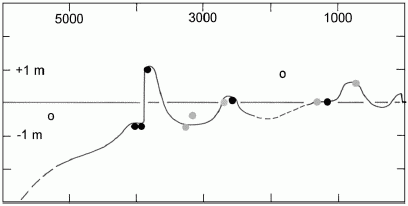
Postponement of events due to inclement weather are very commonplace. However, the postponement of an event scheduled for 9th January by the Oregon Environmental Council was particularly ironic as the event in question was a talk and discussion by Dr Jonathan Patz - on global warming. And the reason for the postponement? - Snow, ice and freezing rain (sic.) "Due to inclement weather and massive amounts of ice everywhere, tonight's healthy Environment Forum on Global Warming with Dr. Patz has been postponed", wrote Sarah Doll of the Oregon Environmental Council in an email sent to the press, "Sorry for any inconvenience and hope you are staying warm." There's no beating that punch line. A Return to Rationing in Britain? (11 Jan 04) According to a BBC report, British Greenhouse scientists from the Tyndall Centre in Cambridge have devised a new and sinister snake-oil cure for Britain's carbon emissions - rationing. Britain has a lot of experience historically with rationing, having imposed it on a broad range of goods during and after the Second World War, plus some months of petrol rationing during the Suez Crisis of 1956. The new proposal is actually a rehash of the old rationing system drawn straight from British experience of those dismal times - assign a fixed ration to every adult (in this case a ration of carbon emitting products) and allow people to buy and sell any unused credits. The rationale is of course for Britain to single-handedly `cure' global warming. There is one fundamental difference however - those earlier times were associated with war and national crisis and clearly understood at the time to be purely temporary. This proposal seeks to entrench petrol, oil and gas rationing in perpetuity, without the benefit of a national crisis to galvanise public support. In a small over-crowded country of nearly 60 million, a permanent system of rationing for energy would impose enormous social stresses of a kind scarcely seen before. One result would certainly be an increase in emigration by Britain's most productive workers and professionals rather than tolerate the grey dismal life which would follow in the train of rationing such a fundamental product of living. To implement such a system would result in the creation of an `informer' state as the bureaucracy needed to enforce such a system would be enormous (itself a big waste of carbon emissions). All such rationing schemes in the past in any country in which it has been implemented has resulted in flourishing black markets, profiteering, and involvement by organised crime. Britain could scarcely expect anything different. In a nutshell, Britain would become a thoroughly miserable place in which to live and it is puzzling that the British government should describe this proposal as a `welcome contribution to the climate change debate'. |
![]()
Return to `Still Waiting For Greenhouse' main page